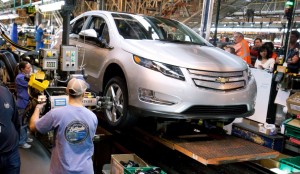Despite all the breathless headlines and accolades, sales of a new generation of battery cars have gotten off to a slow start – in part due to the consciously slow ramp-up of production by makers like General Motors and Nissan.
But more of the vehicles will be rolling off the assembly line in the weeks ahead. General Motors, in particular, says that after a brief shutdown to re-tool for the 2012 model-year, it will sharply increase production of the new Chevrolet Volt, and should have 16,000 of the plug-in hybrids in dealer showrooms or customer hands by year’s end.
The Detroit plant building the Volt will be even busier next year, with production expected to surge as high as 60,000 – with a quarter of that volume earmarked for China and other overseas markets.
“The Volt will be available to customers nationwide by the end of 2011,” said Cristi Landy, director of Chevrolet Volt Marketing. “By taking the time to reconfigure the plant, we will be better able to meet the tremendous consumer demand.”
Since the Volt came onto the market at the end of 2010 sales have been modest, at best, barely topping the 1,000 mark, though GM has insisted that is the result of limited availability, rather than low demand. Nissan has made the same argument about it Leaf battery-electric vehicle, or BEV, which also debuted in December of last year. By the end of May, total Leaf sales will only approach 2,000, according to industry analysts.
But the Japanese maker has also announced plans to sharply increase factory output, a move that was delayed by the March 11 earthquake and tsunami that effectively shut down the Japanese auto industry for the better part of a month.
In fact, a boatload of Nissan Leaf battery cars had only just left port when the disaster hit, since then helping stock U.S. dealers facing a shortage of many Japanese-made vehicles.
GM is planning a four-week summer shutdown of its so-called Poletown plant, in Detroit, the factory producing the Volt as well as several other products. That will actually mean even lower availability in June and July, Landy cautioned.
When the Poletown plant comes back up, however, production of the plug-in will significantly increase. That will allow the maker to expand the number of markets where Volt is currently offered.
The 2011 model is currently available only in California, Connecticut, Maryland, Michigan, New Jersey, New York, Texas, Virginia and Washington, D.C. The rest of the country will come online, while Volt will begin being shipped to foreign markets that include China, Europe and Canada.
Meanwhile, the factory will also begin production of a sibling battery car, the Opel Ampera, which is primarily targeted to Europe. But the more sporty-looking Ampera will be sold alongside Volt in some markets, notably including China.


GM has to get the Volts available, because they have virtually no competition now that the Prius, granted a hybrid, has hit a roadblock. If GM can get the Volt priced right, Prius definitely has competition, albeit from a slightly different direction.